
The Thomisidae are a family of spiders, including about 175 genera and over 2,100 species. The common name crab spider is often linked to species in this family, but is also applied loosely to many other families of spiders. Many members of this family are also known as flower spiders or flower crab spiders.
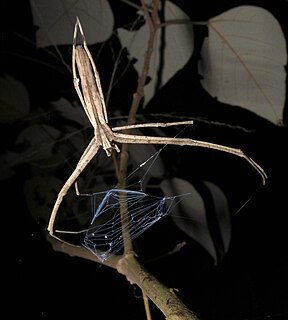
Deinopidae, also known as net casting spiders, is a family of cribellate spiders first described by Carl Ludwig Koch in 1850. It consists of stick-like elongated spiders that catch prey by stretching a web across their front legs before propelling themselves forward. These unusual webs will stretch two or three times their relaxed size, entangling any prey that touch them. The posterior median eyes have excellent night vision, allowing them to cast nets accurately in low-light conditions. These eyes are larger than the others, and sometimes makes these spiders appear to only have two eyes. Ogre-faced spiders (Deinopis) are the best known genus in this family. The name refers to the perceived physical similarity to the mythological creature of the same name. This genus also includes the humped-back spiders (Menneus).
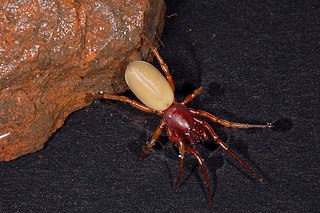
Dysderidae, also known as woodlouse hunters, sowbug-eating spiders, and cell spiders, is a family of araneomorph spiders first described by Carl Ludwig Koch in 1837. They are found primarily in Eurasia, extending into North Africa with very few species occurring in South America. Dysdera crocata is introduced into many regions of the world.
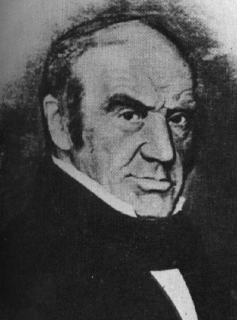
Carl Ludwig Koch was a German entomologist and arachnologist. He was responsible for classifying a great number of spiders, including the Brazilian whiteknee tarantula and common house spider. He was born in Kusel, Germany, and died in Nuremberg, Germany.

Ludwig Carl Christian Koch was a German entomologist and arachnologist.

The black house spider or common black spider is a common species of cribellate Australian spider, introduced to New Zealand and Japan. A closely related species, Badumna longinqua, the grey house spider, has a similar distribution, but has also been introduced to the Americas.

Abracadabrella is a genus of spiders in the family Salticidae whose spp. appear to mimics flies. The type species for the genus was described by Ludwig Koch (1879) as Marptusa elegans, transferred to Ocrisiona by Eugène Simon (1901) then placed into Abracadabrella by Marek Żabka (1991).

Clynotis is a genus of spiders in the family Salticidae, or jumping spiders, contained within the subfamily Marpissinae. They are found across Australia and New Zealand, with some species occupying the Auckland Islands and one found exclusively on Snares Island. There are eight species currently described within the genus, the earliest noted being the type species Clynotis severus, first described in Queensland, New South Wales, Australia in 1879 by Ludwig Carl Christian Koch. The most recent was described in 1931 by Lucien Berland. Two other species previously held within the genus were subsequently reclassified into the genus Tara.

Marpissa is a genus of jumping spiders that was first described by Carl Ludwig Koch in 1846. The name is derived from Marpissa, an ancient Greek village.

Opisthoncus is a genus of South Pacific jumping spiders that was first described by Ludwig Carl Christian Koch in 1880. There are still many Australian species that have not yet been described.
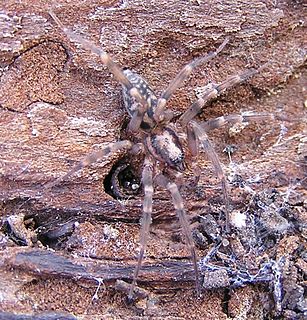
Liocranum is a genus of spiders in the family Liocranidae. The genus was first described by Ludwig Carl Christian Koch in 1866.

Isopeda is a genus of huntsman spiders that was first described by Ludwig Carl Christian Koch in 1875.
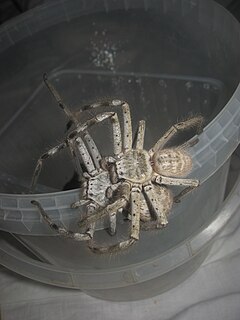
Holconia immanis, commonly known as the Sydney huntsman spider, is a species of huntsman spider found in eastern Australia.

Arkyidae is a family of araneomorph spiders first described by Ludwig Carl Christian Koch in 1872 as a subfamily of Araneidae, and later elevated to a full family in 2017.
Ischalea is a genus of intertidal spiders that was first described by Ludwig Carl Christian Koch in 1872. As of September 2019 it contains three species, found in Mauritius, on Madagascar, and the Polynesian Islands: I. incerta, I. longiceps, and I. spinipes. Originally placed with the Pisauridae, it was moved to the Stiphidiidae in 1973, and to the Desidae after a 2017 genetic study.
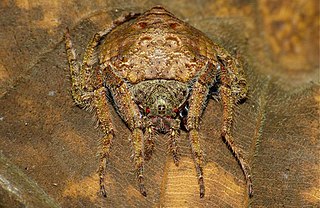
Dolophones conifera, known as the wrap-around spider, is a species of spider in the family Araneidae indigenous to Australia. It is named for its ability to flatten and wrap its body around tree limbs as camouflage. It is found in Western Australia along with several other species from the genus Dolophones, and was first described in 1886.
Hedana is a genus of crab spiders that was first described by Ludwig Carl Christian Koch in 1874.
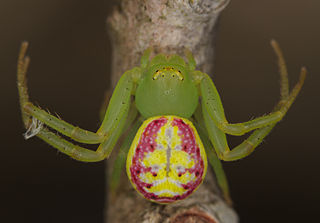
Tharrhalea is a genus of crab spiders first described in 1875 by Ludwig Carl Christian Koch.
Australomisidia is a genus of spiders in the family Thomisidae. It was first described in 2014 by Szymkowiak. As of 2017, it contains 8 species, all from Australia.
Bomis is a genus of crab spiders that was first described by Ludwig Carl Christian Koch in 1874.















